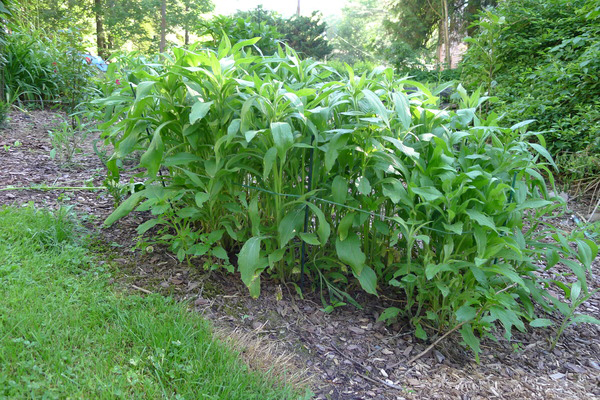

I was walking past a shop about six weeks ago that has a really nice 10-by-20-foot garden in front of it. From May through October, there’s always something in bloom but on this particular day I was disturbingly distracted from the garden’s beauty. Several bearded iris were staked, with stakes 2 feet taller than the plants, and it was the stakes that caught my eye, not the iris.
Garden stakes, supports and the ties that connect the plants to these devices should not be garden distractions, no matter how artistic or thoughtful. Rather, they should blend, become part of the structure, be invisible, or visually become part of the plant they are supporting. If they don’t, the beauty of the plant is lost and no matter how artistic or how well planned the support is it becomes a distraction or even a detraction.
But giving garden plants the right support that accomplishes these goals is both a talent and an art that requires knowledge of materials and methods.
The staking that’s available at garden centers usually comes in several forms and colors. There is the ubiquitous bamboo stake that is a natural light brown in color or its green stained counterpart. These stakes are available in uniform lengths—from 2 feet to 8 feet in height and from about a quarter of an inch in diameter to nearly a half inch thick. They can be cut to size, but the cut ends should not go into the soil as the solid ends are, well, solid.
The next type of stake is the cedar or hardwood stake. These are square-cut, have a natural wood color and range from 3 feet to 8 feet in height. More costly than bamboo, they are easier to set in the ground, support more weight and can last for three to five years as opposed to the bamboo’s two years.
Next we move on to the metal stakes. These can range from thin wire to half-inch-thick stakes, with the thinnest being slightly pliable and the thickest being rigid and stiff. They are usually painted one of several shades of green, often not matching any stem or branch color, and there are short types that are curled at the ends or along the length to enable the stake to entwine the plant stem.
The less expensive varieties (okay, they’re cheap) will often bend or break when inserted into hard ground or when they hit a rock. On the other hand, the quality metal stakes are often plastic- or rubber-coated and are quite resistant to breaking unless they’re bent, causing them to snap.
My favorite metal stake is made by Takiron. It comes in various thicknesses and heights and will last for years. But even this will bend and break if misused. A hint: there are points on one end for a reason.
There are also fiberglass stakes, similar to the stakes used as driveway markers during the snow season. I’ve stopped using these because when the shaft of the stake is grabbed you can get fiberglass splinters in your hands, causing more than mere irritation.
Lastly, there are the natural stakes, such as twigs and branches.
I was recently cutting back my lilacs when I realized that the long and heavy flower stems of the nearby peonies needed some support. I simply trimmed down the 3- and 4-foot lilac trimmings, removed the foliage and cut the branches to fit each peony stalk. With the ends cut at an angle, they easily slipped into the ground and the color of the twigs blended perfectly with the stems of the peonies.
During the winter months I cut branches from beech trees, as these make wonderful garden stakes and supports and their branching habit allows for fanned and trellised supports. The branches and twigs are cut in February but not trimmed until I find a use for that particular branch. The color is perfect and you can never spot them in the garden.
For natural upright staking I use the stems pruned from the apple orchard in late winter. These can be 2- to 5-feet long and a quarter of an inch to a half inch thick.
Apple is one of the strongest woods and it makes great stakes with infinite applications. One semi-dwarf apple tree can yield a dozen or more stakes a year.
Now for the connection: making the tie between the stake and the plant.
Here too there are natural and man-made choices in two colors—”natural” and green. And here again the green is often any color of green except the one that blends in.
Jutes, sisal and synthetic twines are common choices. They’re inexpensive and easy to work with.
The downside is that due to the thinness of twines, any resistance that the material offers against a stem can be an issue with wind or weight with the twine causing the stem to break or bend. So, twines are best used for light connections.
In most cases, you should not tie your stem or plant directly to your support. Instead, use a “figure 8” tie, in which the tie is turned around the stem with one circle then around the support with another circle then tied. This allows some movement of the stem but still gives ample support without too much resistance.
I use a plastic or vinyl ribbon tape for many applications. It comes only in green but in various widths under the Bond brand name. The tape is pliable, stretchable and very strong. When properly tied (still using a figure 8) it allows for a great deal of support and strength while being lightweight. Unlike natural materials, like jute, this tape will not break down even after years in the garden, which can be both a plus and a minus.
Twist ties have been around since dirt was invented. You can buy pre-cut ties or ties on a roll or spool. They come in two forms: one with a paper edge and another with a plastic edge, both being reinforced by a wire down the middle. I haven’t used this type of tie in years because I often found the wire would cut the stems but if it works for you, fine, just be careful.
The most recent addition to the tie material list is a foam-coated wire called “Flori-Fix,” which is imported from Belgium. This material has a 10-milimeter-thick diameter and is stiff but pliable and bendable, making it great for connecting a thick stake to a thick stem where the maximum amount of support is needed.
My largest stakes are on my tallest plants—my late-flowering lilies, which can be 6- to 8-feet tall. These all get Takiron stakes and are tied with Flori-Fix.
Those are the basic choices but I’m sure you can find more, and I’m sure you can be inventive. Just keep in mind, the support should not be the object or draw the attention. It should do a job and do it invisibly, which is sometimes easier said than done. But that’s just another of the challenges for the artful gardener.
The biggest challenge, though, is that some plants continue to grow but their stakes don’t. A stake taller than a plant is an obvious distraction but by the same token it’s a real pain to have to re-stake every few weeks.
The solution: the Hampton Gardener’s telescoping garden stake. It should be available at your local garden center within the next 10 to 15 years. In the meantime, keep growing.
 More Posts from Andrew Messinger
More Posts from Andrew Messinger